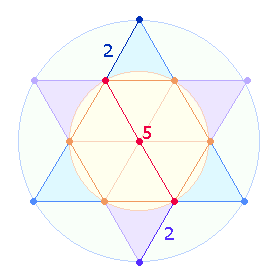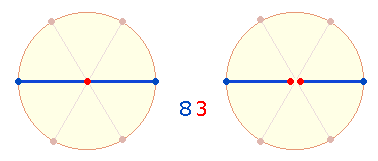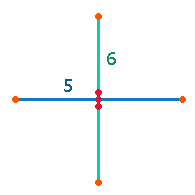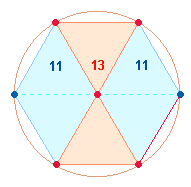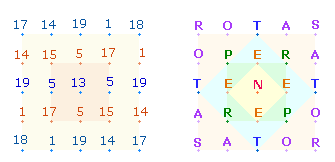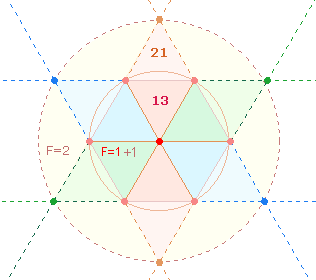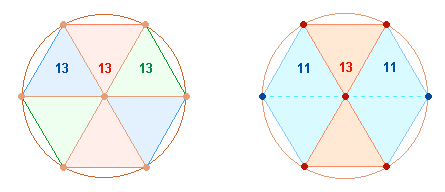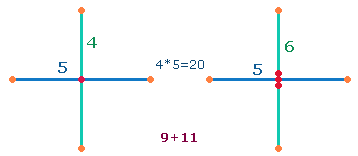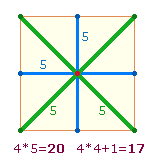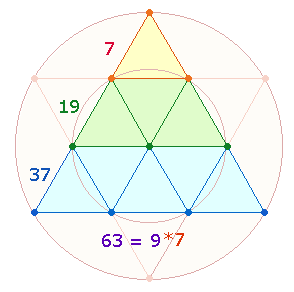Alphabets;
gematric calculator
Ovid's and
Shakespeare's Epitaphs
ALLITERATIONS in
Shakespeare's Epitaph
I. 4+1 word
groups
II. 11 INITIALS
III. 569, YIOS and ILLI
I.
4+1 word groups
1.
The alliterations in Shakespeare's epitaph are another
miracle of his mathematic magic. There are 5
groups of alliterating words, one group consisting of 3,
the others of 2 words:
GOOD FREND FOR IESVS SAKE FORBEARE
TO DIGG THE DVST ENCLOASED
HEARE.
BLESTE BE YE
MAN YT SPARES
THES STONES
AND CVRST BE HE
YT MOVES
MY
BONES.
Shakespeare has two geometric models in mind: The first is the
hexagram with its 5 diametric
elements of the hexagon and its extension to 2+2
further elements:
|
|
The 5 diametric elements can be subdivided into
3+2 elements. This first model comprises the first three
lines.
The
second model is the hexagonal axis. As each of the two radial lines is
delimited by two points, 6
radial elements can be counted and have to be added to 5 diametric
elements. The number 3 this time
refers to 3 midpoints:
|
|
Alternatively, this double aspect can be represented by a cross of axes
with three midpoints:
|
|
The second model comprises all four lines.
2. The 4values of the 9 alliterating
words in the first three lines are:
|
|
|
NS |
FV |
sm |
FS |
FV |
sm |
tot |
|
1 |
FREND |
45 |
11 |
56 |
44 |
15 |
59 |
115 |
|
|
FOR |
37 |
37 |
74 |
31 |
31 |
62 |
136 |
|
|
FORBEARE |
67 |
67 |
134 |
61 |
61 |
122 |
256 |
|
2 |
DIGG |
27 |
9 |
36 |
24 |
9 |
33 |
69 |
|
|
DVST |
61 |
61 |
122 |
40 |
11 |
51 |
173 |
|
3 |
BLESTE |
60 |
12 |
72 |
50 |
12 |
62 |
134 |
|
|
BE |
7 |
7 |
14 |
7 |
7 |
14 |
28 |
|
4 |
SPARES |
74 |
39 |
113 |
47 |
47 |
94 |
207 |
|
|
STONES |
87 |
32 |
119 |
62 |
33 |
95 |
214 |
|
|
|
465 |
275 |
740 |
366 |
226 |
592 |
1332 |
|
740:592 = 37*(16:20)=37*36 = 4*37*(5:4) = 148*9 |
||||||||
The
FV are added to their corresponding sums.
This is a variation of the usual combination of NS+FS and FV1+FV2.
There are two interior partial ratios: The NS of
the two outer word groups is double as high as the inner wordgroups: 310+155 = 5*31*(2:1).
The third
and fourth wordgroups together form a ratio of their two combinations (NS+FS):(FV1+FV2):
318:265 = 53*(6:5).
The
total sum 1332 = 12*111 can be understood as the sum of the six
inversions of 123, which is the FS 52+71 of WILLIAM
SHAKESPEARE.
3. The 4values of all 5
wordgroups are:
|
|
|
NS |
FV |
sm |
FS |
FV |
sm |
tot |
|
1. |
FREND |
45 |
11 |
56 |
44 |
15 |
59 |
115 |
|
|
FOR |
37 |
37 |
74 |
31 |
31 |
62 |
136 |
|
16 |
FORBEARE |
67 |
67 |
134 |
61 |
61 |
122 |
256 |
|
2. |
DIGG |
27 |
9 |
36 |
24 |
9 |
33 |
69 |
|
8 |
DVST |
61 |
61 |
122 |
40 |
11 |
51 |
173 |
|
3. |
BLESTE |
60 |
12 |
72 |
50 |
12 |
62 |
134 |
|
8 |
BE |
7 |
7 |
14 |
7 |
7 |
14 |
28 |
|
4. |
SPARES |
74 |
39 |
113 |
47 |
47 |
94 |
207 |
|
12 |
STONES |
87 |
32 |
119 |
62 |
33 |
95 |
214 |
|
5. |
MOVES |
69 |
26 |
92 |
38 |
21 |
59 |
154 |
|
7 |
MY |
35 |
12 |
47 |
30 |
10 |
40 |
87 |
|
51 |
|
569 |
313 |
882 |
434 |
257 |
691 |
1573 |
|
1573 =
11*13*11 > 35 |
||||||||
|
434 = 14*31 |
||||||||
The
factors 11*13*11 represent the elements of three
figures within the hexagon, symbolizing the three Divine Persons:
|
|
The right figure can be regarded as the First Person, the left as the
Second Person, the image likeness of the Father, and the middle figure as the
Holy Spirit.
The FV 35 is identical
with the NS of MY which is to be understood as the initials of MARIAE YIOS,
Mary's Son. One meaning of the common factor 53 in
the table – and inversion of 35 – is the NS of
the word MARY.
We can also observe the trinitarian principle in the FV1-sum
313 and the FS 434 = 14*31.
4. The sums of
letters of the first 4 groups are each
divisible by 4. The symmetrical centre of
the total sum of 51 letters follows after
letter 24 of the first two alliteration
groups. The 4value-sum of the first two
groups is 749. The 25th
and 26th letters as the
constituent numbers for number 51 could
aptly be the word BE,
which follows after BLESTE. The 4v-sum 28 of BE
added to 749 = 777,
however, enables another ratio of the first four alliteration groups: 777:555 = 3*37*(5:7).
The
central word BE and
the exchange of BLESTE BE to BE BLESTE can be differently interpreted:
–
The numbers 5 and 7 can be related to the double
rhombus: 5 points of the double triangle
belong to the hexagonal circle, the other 2
points to the outer ring of the second circle. As the surface (F) ratio of the hexagonal circle to the outer circle
is 1:3, the 5 and 7 points
represent this trinitarian ratio:
|
|
The same surface ratio 1:3 is
also represented by 3:5 radial elements
of the diametrical zig-zag line.
This is the main reason for the high significance of the number 35 and
its inversion 53. Double the sum is the NS and
NS+FS of IESUS (70, 106).
The NS of MY is 35,
and if we may associate it with Mary and MarY's
son, Shakespeare achieved this particular gematric construction in praise and
veneration for the Virgin Mary and her son Jesus.
–
If the the two words are exchanged
to BE BLESTE, the text cannot be
syntactically continued. They rather complete the addressing first two words: GOOD FREND, BE BLESTE. If we combine the four
words crosswise, their 4values form a ratio
with 13 as the common factor:
|
|
NS |
FS |
sm |
FV1 |
FV2 |
sm |
tot |
|
FREND |
45 |
44 |
89 |
11 |
15 |
26 |
115 |
|
BE |
7 |
7 |
14 |
7 |
7 |
14 |
28 |
|
|
52 |
51 |
103 |
18 |
22 |
40 |
143 |
|
GOOD |
39 |
29 |
68 |
16 |
29 |
45 |
113 |
|
BLESTE |
60 |
50 |
110 |
12 |
12 |
24 |
134 |
|
|
99 |
79 |
178 |
28 |
41 |
69 |
247 |
|
143:247 = 13*(11:19) = 390 |
|||||||
The result 390 is ten times
the NS 39 of GOOD. One might read the 4 words as FREND,
BE GOOD [and] BLESTE.
The
word BE (in the original order) concludes the
first half of the epitaph's 28 words. So by
exchanging the two alliteratin words, Shakespeare has found a means to come to a
premature end and to avoid the frightening curse. He corroborates this
intention by another miraculous gematric construction: The combination NS+FS and
FV1+FV2 form a ratio by 31:
|
NS |
FS |
sm |
FV1 |
FV2 |
sm |
tot |
|
622 |
494 |
1116 |
326 |
294 |
620 |
1736 |
|
1116:620 = 31*(36:20) = 124*(9:5) |
||||||
The 4values of the epitaph words
can be looked up under addendum2.
The ratio numbers 9:5 refer again to the zigzag-line of the hexagram: 9:5 diametrical elements
represent the surface ratio 3:1 of the two concentric circles.
The FV of the common factor 124
= 4*31 is 35, which, as has
been shown, represents the area ratio 1:3.
–
BE as the sixth alliteration word
is, after its exchange for BLESTE, the
symmetrical centre of the 11 words. It
reminds of Hamlet's famous soliloquy
"To be or not to be, that
is the question/the point".
As
a single word, BE now
appears like an answer to this question, a call upon the GOOD FREND TO BE, i.e., "to bear the whips and scorns of time" in order to be
received by the "everlasting Judge" into the realm where "the
happy smile".
The
gematric numbers for the two letters BE are 2+5.
The square number 25 = 5*5 with its FV 10 represents the
eternal laws of being. It can again be referred to the 2+5 points of the
double rhombus and the 5+5
radial elements of the hexagram. The correspondent area units are 2+1 and
3+3. It
is connected to the number 35 by FV
10 + NV 25 = 35 = 5*(2:5).
Especially the SATOR square with its 25
letters is a model of the decimal system:
|
|
5.
The total 4value-sum
1573 is composed of single sums which are
divisible by 13 or 11:
|
group |
1 |
2 |
3 |
4 |
5a |
5b |
|
|
4v-sm |
507 |
|
162 |
421 |
|
87 |
|
|
|
|
242 |
583 |
154 |
|
|
|
|
*11 |
|
22 |
53 |
14 |
|
89 |
|
|
507 = 39*13; 507+87 = 594 = 54*11 |
|||||||
|
11*(54+89) = 11*143 = 11*13*11 |
|||||||
The first word GOOD with the NS 39 is the motto for the first
alliteration group. The product 3*13 is represented
in its single digits by the 7 points of the
double rhombus:
|
|
1. The 11 alliteration words correspond to 11 letters of SHAKESPEARE. The 4values
of the initials show this intention:
|
|
NS |
FV |
sm |
FS |
FV |
sm |
tot |
|
FFFDDBBSSMM |
90 |
13 |
103 |
57 |
22 |
79 |
182 |
103 is the NS of SHAKESPEARE, 182 the 4values of WILLIAM,
the NS of SATOR OPERA TENET and
IESUS CHRISTUS, and the NS+FS of PENSATOR.
The NS 1242 of the whole epitaph is
divisible by 18 like
90 so that there is the ratio 18*(5:64).
2. The 11 letters
and their values are adjusted to WILLIAM's. The
combined results produce numerous ratios:
|
|
NS |
FS |
sm |
FV1 |
FV2 |
sm |
tot |
|
FFFDDBBSSMM |
90 |
57 |
147 |
13 |
22 |
35 |
182 |
|
WILLIAM |
74 |
52 |
126 |
39 |
17 |
56 |
182 |
|
|
164 |
109 |
273 |
52 |
39 |
91 |
364 |
|
147:126 = 21*(7:6); |
|||||||
|
52:39 = 13*(4:3); 91:273= 7*13*(1:3) |
|||||||
Shakespeare's main theme is the trinitarian ratio 1:3.
The letter Y
with its NV 22 and FV 13
refers to the correspondence of 2:3
radial elements to 2:1 area units (F).
The NS+FS of Shakespeare's epitaph is 2213!
The
surface ratio 1:3 is also represented by 7 hexagonal points and 13 points of the hexagram. The same ratio is
suggested by the number 273 = 21*13
with reference to the 21 elements of
the double rhombus, of which 13 elements
belong to the hexagonal part:
|
|
3. Shakespeare's
special interest in 39 has to do with his
initials WS:
|
|
W |
S |
sm |
FV |
tot |
|
NV |
21 |
18 |
39 |
16 |
55 |
|
FV |
10 |
8 |
18 |
8 |
26 |
|
|
31 |
26 |
57 |
24 |
81 |
|
|
|||||
The internal difference between the ratio
factors 6 and 13 is 7.
There are three double-triangles in the hexagon each consisting of 6
lines and 5 points + 2 areas:
|
|
It is worth mentioning that the elements of both patterns of
double-triangles (39+35) amount to the NS 74 of WILLIAM.
If the 7 points of the hexagon are numbered from 1-7, the
numeration sum of the three double-triangles of the 39
pattern is 57 (of the 35
pattern it is 50) which is the NS+FS of WS and
the 11 initials:
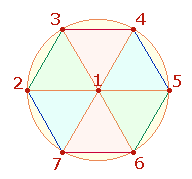
The sums are 19 (blue), 21 (middle), 17 (green).
1. The NS 569 of the 11
alliteration words is a prime number. Read as (5+6)+9, it represents two coordinate systems, one axis
consisting of 5 elements. To compensate for one
midpoint only, which amounts to 9 elements,
the second axis has to be given two midpoints so that the total is 4*5 = 20 elements:
|
|
2. The NS+FS of YIOS is 63+36 = 99 = 9*11. The
same applies to the accusative YION (58+41), the son whom
the Virgin Mary should conceive according to the Angel's message. Twice YIOS and once YION
make the NS+FS 297
= 27*11 = FV
9+11.
3. The equivalent
letters for 9+11 is IL which play an important role
in the name of WILLIAM:
|
|
L |
I |
sm |
FV |
tot |
|
NV |
11 |
9 |
20 |
9 |
29 |
|
FV |
11 |
6 |
17 |
17 |
34 |
|
|
22 |
15 |
37 |
26 |
63 |
There
is first the curious fact that the NS+FS of ILLI is identical with the NS 74 of WILLIAM and the NS+FS of W-AM
identical with the FS 52. The numbers 20+17 = 37 points to a square with four axes with again 5 elements for each. If only one midpoint is
counted the 20 elements are reduced to 17:
|
|
If
the FV 9+17 = 26 are added, a new peculiarity
appears: The 4values of ILLI are identical with the NS+FS 126 of WILLIAM.
IL alone refers to three double-rhombi which
each consist of 21 elements. If two are
arranged as a coordinate system, an octahedron can be formed one half of
which consists of 17
elements and the second half of 9
remaining elements. If each double rhombus is combined with each, 6 of them are needed for three octahedra.
One tetractys is built up in three levels whose elements amount to 7+19+37
= 63:
|
|
4. Shakespeare, of
course, new the meaning of Latin ILLI: to/for that (person). It might be humorously
referred to the following name SHAKESPEARE
if the palindromic values are put together as 3-digit numbers: 119+911 = 1030. 103 is the NS of SHAKESPEARE.
5. It should be
logic that the values of 9+11 alliteration
words be added up. Noone knows how Shakespeare could
plan such result so far in advance. I confine myself to the 4v-sum:
|
|
|
|
sm |
FW |
sm |
FW |
|
4vs |
1332 |
1573 |
2905 |
95 |
|
|
|
FW |
47 |
35 |
82 |
43 |
|
|
|
sm |
|
|
2987 |
138 |
3125 |
20 |
|
FW |
|
|
132 |
28 |
160 |
15 |
|
2905 = 5*7*83 |
35 |
|||||
|
2987 = 29
*103 |
||||||
The 4v-sum 2905
contains like the 4v-sum 3320 of the
whole epitaph the factor 83. 103 is the NS of SHAKESPEARE and the NS+FS is 6*29 = 174.
